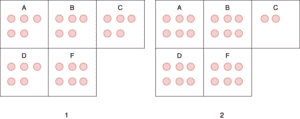1. 概述
鸽巢原理(Pigeonhole Principle)是数学中的一个简单但非常有力的工具,它可以帮助我们证明一些看似反直觉的结论。本文将从基本原理讲起,逐步介绍其推广形式,并通过多个示例展示其在实际问题中的应用。
我们会先定义什么是鸽巢原理,然后通过几个例子说明它的使用方式。接着引入广义鸽巢原理,并给出相应的证明和实例。最后展示一些较为巧妙的应用,帮助你真正理解它的威力。
2. 基本鸽巢原理
2.1 定义与证明
鸽巢原理的基本形式是这样的:
如果有
n个盒子,放入n+1或更多物体,那么至少有一个盒子里包含两个或以上的物体。
这个原理虽然看起来显而易见,但它是数学推理中非常基础的工具之一。我们可以通过反证法来证明它:
假设每个盒子最多只能放一个物体。那么最多只能放 n 个物体。但题目中说我们放入了 n+1 个物体,这就产生了矛盾。因此,至少有一个盒子必须包含两个或以上的物体。
2.2 示例一:英文单词首字母重复
假设有 27 个英文单词,那么至少有两个单词的首字母是相同的。
- 鸽巢:26 个英文字母(盒子)
- 鸽子:27 个单词(物体)
根据基本鸽巢原理,27 > 26,因此至少有一个字母被两个单词同时使用作为首字母。
2.3 示例二:生日问题
任意 367 个人中,至少有两个人生日相同。
- 鸽巢:366 个可能的生日(包括闰年的 2 月 29 日)
- 鸽子:367 个人
根据鸽巢原理,367 > 366,因此至少有两个人生日相同。
2.4 示例三:头发数量问题
假设一个人最多有 k 根头发,那么任意超过 k 人的群体中,至少有两个人头发数量相同。
- 鸽巢:从 0 到
k的头发数量(共k+1个) - 鸽子:超过
k+1人
因此,根据鸽巢原理,至少有两个人具有相同的头发数量。
⚠️ 实际上,人类平均头发数量约为 10 万根,最大值通常不超过 20 万。因此,在 20 万人中,必然有两人头发数量相同。
3. 广义鸽巢原理
3.1 定义与证明
广义鸽巢原理是对基本原理的扩展:
若有
n个物体放入k个盒子中,则至少有一个盒子中包含至少⌈n/k⌉个物体。
证明思路:
假设每个盒子最多有 ⌈n/k⌉ - 1 个物体。那么所有盒子最多有 k * (⌈n/k⌉ - 1) 个物体。我们可以通过代数推导发现这个值小于 n,与题设矛盾。
因此,至少有一个盒子必须包含至少 ⌈n/k⌉ 个物体。
3.2 示例一:100 人出生月份分布
100 人中,至少有 ⌈100/12⌉ = 9 人出生在同一个月份。
- 鸽巢:12 个月
- 鸽子:100 人
因此,至少有一个月份包含至少 9 人。
3.3 示例二:扑克牌选牌问题
从标准扑克牌(52 张,4 种花色)中选出若干张牌,要确保至少有 3 张同花色,最少要选几张?
我们使用广义鸽巢原理:
- 鸽巢:4 种花色
- 要求:每个盒子中至少有一个包含 3 张牌
即求最小的 n,使得 ⌈n/4⌉ ≥ 3。解得 n = 9。
✅ 所以至少要选 9 张牌才能确保有 3 张同花色。
3.4 示例三:学生成绩分布
要确保至少 6 个学生获得相同成绩,且成绩有 5 个等级(A、B、C、D、F),最少需要多少学生?
- 鸽巢:5 个等级
- 要求:至少一个等级有 6 人
即求最小的 n,使得 ⌈n/5⌉ = 6。解得 n = 26。
✅ 所以至少需要 26 名学生才能满足条件。

4. 鸽巢原理的巧妙应用
4.1 示例一:整除关系
在任意 n+1 个不超过 2n 的整数中,必然存在两个数,其中一个能整除另一个。
思路:
将每个数表示为 2^k * q 的形式,其中 q 是奇数。由于 q 的取值范围最多只有 n 个不同的奇数,而我们有 n+1 个数,根据鸽巢原理,至少有两个数的 q 相同,因此这两个数中较大的那个一定是较小的那个的倍数。
4.2 示例二:连续天数比赛次数
某运动队连续 30 天每天至少打 1 场比赛,总共最多打 45 场。那么一定存在连续若干天,刚好打了 14 场比赛。
思路:
设 x_j 表示前 j 天累计比赛场数。构造序列 x_1, x_2, ..., x_30 和 x_1 + 14, x_2 + 14, ..., x_30 + 14。这两个序列共 60 个数,最大值不超过 59,根据鸽巢原理,必有重复值。这个重复值意味着存在两个天数 i 和 j,使得 x_i - x_j = 14,即从第 j+1 天到第 i 天刚好打了 14 场比赛。
5. 总结
通过本文的讲解,我们系统地了解了鸽巢原理及其推广形式:
- 基本鸽巢原理适用于判断是否存在重复项,如生日、单词首字母等场景
- 广义鸽巢原理则能帮助我们估算最大值下限,常用于资源分配、组合优化等问题
- 巧妙应用展示了鸽巢原理在数学证明中的强大能力,尤其在整除性和连续性问题中表现突出
掌握鸽巢原理不仅可以帮助我们快速解决一些看似复杂的问题,还能提升我们对组合数学的理解和直觉。在实际编程、算法设计和系统建模中,它也经常作为关键工具出现。建议读者多练习相关题目,熟练掌握其应用场景和使用技巧。